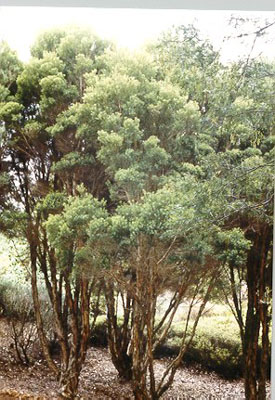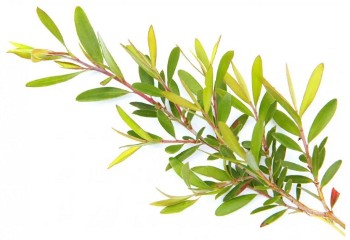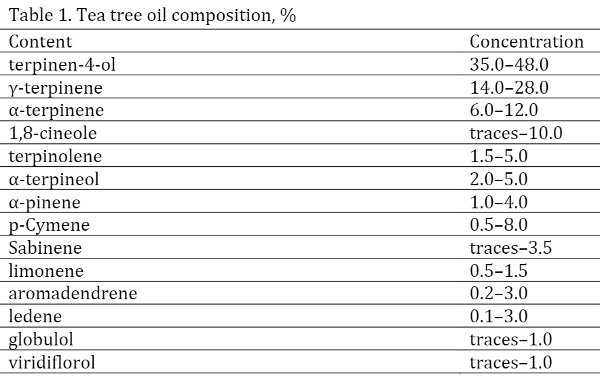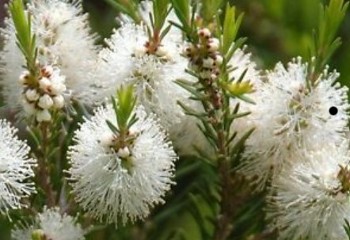Contents:
Common Names | Parts Usually Used | Plant(s) & Culture | Where Found | Medicinal Properties | Biochemical Information
Legends, Myths and Stories | Uses | Formulas or Dosages | How Sold | Warning | Resource Links | Bibliography
Scientific Names

- Melaleuca alternifolia
- Myrtaceae family
Common Names
- Aceite del Árbol de Té
- Australian Tea Tree Oil
- Huile de Melaleuca
- Huile de Théier
- Huile de Théier Australien
- Huile Essentielle de Théier
- Melaleuca Oil
- Oleum Melaleucae
- Ti Tree Oil
Parts Usually Used
Essential oil
Back to Top
Description of Plant(s) and Culture
Melaleuca alternifolia is a small tree to about 7 m (20 ft) with a bushy crown and whitish, papery bark. The leaves are smooth, soft, linear in shape, 10–35 mm (0.4–1 in) long and 1 mm (0.04 in) wide. They are also rich in oil with the glands prominent. Flowers occur in white or cream-colored masses of spikes 3–5 cm (1–2 in) long over a short period, mostly spring to early summer, and give the tree an appearance of looking fluffy. The small woody, cup-shaped fruit, 2–3 mm (0.08–0.1 in) in diameter are scattered along the branches.
Tea tree oil, also known as melaleuca oil, is an essential oil with a fresh camphoraceous odor and a colour that ranges from pale yellow to nearly colourless and clear. Tea tree oil is obtained by steam distillation of the leaves.
Back to Top
Where Found
Tea tree is native to Australia where it occurs in southeast Queensland and the north coast and adjacent ranges of New South Wales. It grows along streams and on swampy flats, and is often the dominant species where it occurs.
Back to Top
Medicinal Properties

Contains powerful antimicrobial, antibacterial, antioxidant, anti-inflammatory, antifungal, antiviral and acaricidal properties. Clinical studies have shown it to be effective against E. coli, Staph. aureus and C. albicans and is similar to that of other broad‐spectrum, membrane‐active disinfectants and preservatives, such as phenol derivatives, chlorhexidine and parabenzoic acid derivatives.
Clicnial studies have demonstrated that topical therapy with 2% butenafine hydrochloride and 5% Melaleuca alternifolia oil incorporated in cream in conjunction with debridement with a nail clipper is safe and significantly more effective than placebo to cure toenail toenail fungus.
Tea tree oil may be a potentially useful cheaper alternative tratment for cold sores.
Clinical studies show that tea tree oil is effective in treating a range of oral bacteria, making it a potential ingredient in toothpastes, mouthwashes, etc.
A recent study showed that tea tree oil is able to impair the growth of human M14 melanoma cells.
Candida albicans is affected by the presence of tea tree oil, making it a possible treatment option.
There is some limited research that has shown that tea tree oil may have anti-viral activity, especially with the Herpes virus (cold sores, chicken pox and shingles blisters, warts, etc.)
Back to Top
Biochemical Information
The oil contains many constituent chemicals and its composition changes if it is exposed to air and oxidizes.

Legends, Myths and Stories

IUCN Red List of Threatened Plants Status
Commercial use of tee tree oil began in the 1920s, pioneered by the entrepreneur Arthur Penfold. As of 2017 the global tea tree oil market was valued at US$39 million.
The use of the name Tea Tree probably originated from Captain James Cook’s description of one of these shrubs that he used to make an infusion to drink in place of tea. Interestingly, ingestion of tea tree is potentially poisonous, so he probably did not drink much or it would have had disastrous effects for him.
For thousands of years, Aborigines used the leaves traditionally for many medicinal purposes, including chewing the young leaves to alleviate headache and for other ailments. They would also use the leaves as an antiseptic and antifungal by crushing the leaves and making a mudpack.
The softness and flexibility of the paperbark itself made it an extremely useful tree to Aboriginal people. It was used to line coolamons when used as cradles, as a bandage, as a sleeping mat, and as material for building humpies. It was also used for wrapping food for cooking (in the same way aluminium foil is today), as a disposable raincoat, and for tamping holes in canoes.
Tea tree oil should not be confused with tea oil, the sweet seasoning and cooking oil from pressed seeds of the tea plant Camellia sinensis or the tea oil plant Camellia oleifera.
Back to Top
Uses
Tea tree oil is applied to the skin for infections such as acne, athlete’s foot, fungal infections of the nail (onychomycosis), scabies, lice, and ringworm.
It is also applied to the skin as a local antiseptic for cuts and abrasions, insect bites and stings, hemorrhoids, for burns, boils, sore throat, vaginal infections, recurrent cold sores, toothache, infections of the mouth and nose, and for ear infections. Tea tree oil is used to prevent and treat infection by certain bacteria that are resistant to antibiotics and for skin rash due to contact with nickel. It is also applied to the skin to eliminate excess body hair in women. On the eyelids it is used for a mite infection at the base of the eyelids. In the hair it is used for dandruff. In the mouth it is used for plaque and gum disease, as well as bad breath.
Some people add it to bath water to treat cough, bronchial congestion, and pulmonary inflammation.
Indigenous Australians of eastern inland areas use tea trees by inhaling the oils from the crushed leaves to treat coughs and colds. They also sprinkle leaves on wounds, after which a poultice is applied. In addition, tea tree leaves are soaked to make an infusion to treat sore throats or skin ailments.
Allergic skin reactions to nickel: Research suggests that undiluted tea tree oil may reduce the area and redness skin reactions in people who are allergic to contact with nickel.
Tea tree oil is also effective for treating insect bites, boils, and minor wounds. It has also been known to help soothe sunburns, poison ivy, ear infections, and bee stings.
In pets, skin problems, wounds, insect bites and stings, and ringworm can all be treated with tea tree oil or products made with tea tree oil. There are some cases where pure tea tree oil placed on the skin of the animal can cause irritation (recovering quickly after discontinuing)
It is considered to be a useful disinfectant and its solvent properties make it a good cleaning product. Its antiseptic and disinfectant properties make it useful to reduce the spread of infection in hospitals. It is also considered an excellent insect repellent and to repel ticks.
Back to Top
Formulas or Dosages
For acne: Applying a 5% tea tree oil gel appears to be as effective as 5% benzoyl peroxide (Oxy-5, Benzac AC, and others) for treating acne. Tea tree oil might work more slowly than benzoyl peroxide, but seems to be less irritating to facial skin.
For infestation of the eyelashes with a type of mite (ocular demodicosis): Weekly scrubs of the eyelid using 50% tea tree oil along with daily scrubs of the eyelid with tea tree shampoo or 10% tea tree oil, applied once or twice per day for 3-5 minutes for up to 6 weeks. For children, use only daily eyelid massages with 5% tea tree ointment.
For nail fungus (onychomycosis): 100% tea tree oil solution applied twice daily for 6 months.
For athlete’s foot (tinea pedis): 25% or 50% tea tree oil solution applied twice daily for one month has been used. Also, 10% tea tree oil cream applied twice daily for one month has also been used.
Mayo Clinic states that tea tree oil is used to treat Lice. When used in combination with lavender oil, tea tree oil has been shown to be effective at treating lice eggs.
For wound dressing: Place a few drops of oil onto fresh wound dressing to kill bacteria and reduce inflammation.
Homemade mouthwash: Add 2 drops of tea tree oil to a cup of water and use as mouthwash. Do not swallow as tea tree oil is toxic if taken internally.
Natural dandruff remedy: Mix a few drops of tea tree oil into regular shampoo and wash hair as normal.
Acne treatment: Add 4 drops of tea tree oil to a half cup of water. Apply to the face with a cotton pad once daily.
Household cleaner: Mix 20 drops of tea tree oil with a cup of water and a half cup of white vinegar. Pour the mixture into a spray bottle and use as an all-purpose antimicrobial cleaner.
How Sold
Sold as topical gel or essential oil. Also included as an ingredient in lotions, soaps, toothpastes and mouthwashes.
Back to Top
Warning
According to Mayo Clinic: Most people can use tea tree oil topically with no problems. However, tea tree oil can cause:
- Skin irritation
- Allergic skin rash (dermatitis)
- Itching
- Stinging
- Burning
- Scaling
- Redness
- Dryness
- Don’t use tea tree oil if you have eczema.
Mayo Clinic states: Tea tree oil is toxic when swallowed. Serious side effects can occur, including:
- Confusion
- A lack of muscle control or coordination of voluntary movements (ataxia)
- Decreasing levels of consciousness
- One study suggests that repeated exposure to lavender oil and tea tree oil might have led to the swelling of the breast tissue (gynecomastia) in young boys.
Tea tree oil should be kept away from pets and children.
Specifically, in dogs and cats, death or transient signs of toxicity (lasting 2 to 3 days), such as lethargy, weakness, in coordination and muscle tremors, have been reported after external application at high doses.
In people with acne, it can sometimes cause skin dryness, itching, stinging, burning, and redness.
Applying products to the skin that contain tea tree oil along with lavender oil might not be safe for young boys who have not yet reached puberty. These products might have hormone effects that could disrupt the normal hormones in a boy’s body. In some cases, this has resulted in boys developing abnormal breast growth called gynecomastia. The safety of these products when used by young girls is not known.
During pregnancy and breast-feeding: Tea tree oil is POSSIBLY SAFE when applied to the skin.
Back to Top
Resource Links
Wikipedia: Melaleuca alternifolia
ScienceDirect: A review of the toxicity of Melaleuca alternifolia (tea tree) oil
Safety, efficacy and provenance of tea tree (Melaleuca alternifolia) oil
Susceptibility of oral bacteria to Melaleuca alternifolia (tea tree) oil in vitro
New World Encyclopedia: Melaleuca
Plants for a Future: Melaleuca alternifolia
Medical News Today: 11 benefits of tea tree oil
Bibliography
![]() Australian Tea Tree Oil: First Aid Kit in a Bottle 3rd Edition, by Cynthia Olsen, Sue Tinkle
Australian Tea Tree Oil: First Aid Kit in a Bottle 3rd Edition, by Cynthia Olsen, Sue Tinkle
![]() Australian Tea Tree Oil First Aid Handbook: 101 Plus Ways to Use Tea Tree Oil 2nd Edition, by Cynthia Olsen
Australian Tea Tree Oil First Aid Handbook: 101 Plus Ways to Use Tea Tree Oil 2nd Edition, by Cynthia Olsen
![]() How to use Tea Tree Oil: 90 Great Ways to Use Natures “Medicine Cabinet in a Bottle” 2nd Edition, by Ruth Elston
How to use Tea Tree Oil: 90 Great Ways to Use Natures “Medicine Cabinet in a Bottle” 2nd Edition, by Ruth Elston
![]() Tea Tree Oil: Discover The Amazing Healing, Beauty, And Detox Scerets Of Tea Tree Oil (Tea Tree Oil – Essential Oils – Home Remedies – Natural Cures), by Sanford Evans
Tea Tree Oil: Discover The Amazing Healing, Beauty, And Detox Scerets Of Tea Tree Oil (Tea Tree Oil – Essential Oils – Home Remedies – Natural Cures), by Sanford Evans
![]() Tea Tree Oil: The Natural Antiseptic, by Dr. Cass Ingram
Tea Tree Oil: The Natural Antiseptic, by Dr. Cass Ingram
